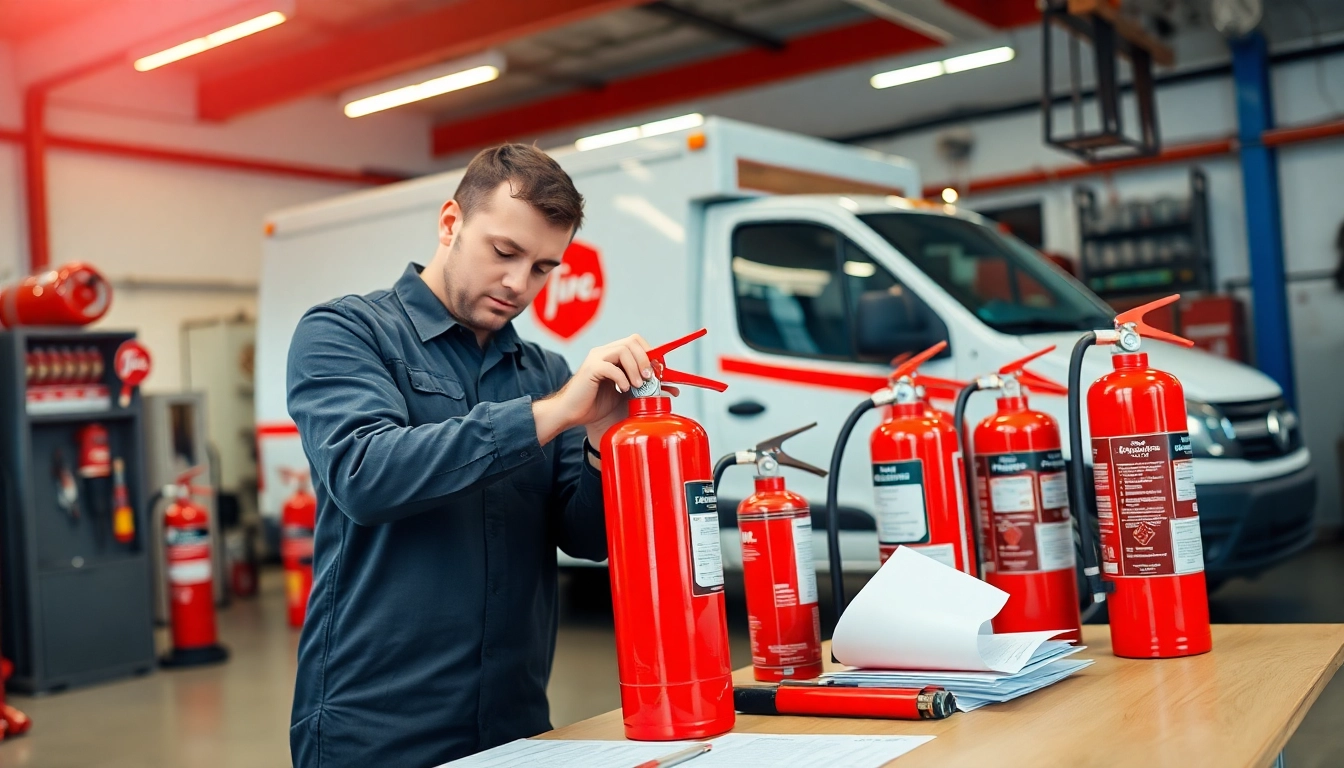Understanding Fire Extinguisher Service
Fire extinguishers are critical components in protecting lives and property from fire hazards. The effectiveness of these devices in an emergency situation largely depends on their proper maintenance, which falls under the umbrella of fire extinguisher service. Understanding what fire extinguisher service entails is essential for both business owners and property managers.
What Is Fire Extinguisher Service?
Fire extinguisher service refers to a broad range of activities aimed at ensuring that fire extinguishers are in good working condition, compliant with legal requirements, and ready for use in emergencies. This includes regular inspections, testing, maintenance, and recharging of extinguishers when necessary. Typically conducted by certified professionals, fire extinguisher service also aims at educating users about the proper operation of extinguishers, increasing the chances of successfully tackling small fires.
Importance of Regular Inspections
Regular inspections are vital as they help identify any potential issues with fire extinguishers, such as damage, corrosion, or low pressure. Inspections should be performed at least once a month by the owner, with a more thorough annual inspection conducted by a professional service provider. Regularly scheduled inspections ensure that all fire extinguishers are compliant with local and national fire codes, which can differ depending on state and municipal regulations. Failing to comply can result in fines and a higher risk of malfunction during an emergency.
Common Types of Fire Extinguishers and Their Requirements
There are several types of fire extinguishers, each designed for specific types of fires. For example:
- Class A Extinguishers: Used for ordinary combustibles like wood, paper, and cloth. They require annual professional inspections and a recharge after use.
- Class B Extinguishers: Designed for flammable liquids such as gasoline, oil, and grease, necessitating similar inspection and maintenance requirements as Class A extinguishers.
- Class C Extinguishers: Used for electrical fires and require careful handling. They should be inspected regularly, with recharges needed after every use.
- Class D Extinguishers: Specially designed for combustible metals and typically used in industrial settings. They have unique maintenance needs due to their specific operational requirements.
- Class K Extinguishers: Used primarily in kitchens for fires involving cooking oils and fats, with specific guidelines for service and operation.
Understanding the type of extinguishers you have and their specific requirements is crucial for effective fire safety management.
Best Practices for Fire Extinguisher Maintenance
Scheduled Inspections: Knowing When to Service
Establishing a routine inspection schedule is one of the best practices for fire extinguisher maintenance. Monthly checks by business owners should involve visual inspections to ensure the extinguishers are accessible, properly labeled, and positioned in accordance with fire codes. Fire extinguishers should be tested and inspected by professionals at least once a year. Furthermore, professional services often involve more in-depth checks, including checking pressure gauges and ensuring that all parts are in operational order.
Essential Maintenance Tasks for Your Extinguishers
Maintaining fire extinguishers involves several essential tasks, including:
- Recharging: Fire extinguishers should be recharged after every use and can also require periodic recharging even if not used.
- Physical Inspection: Look for bumps, dents, or leaks that may affect performance. Ensure the nozzle is clear of any obstructions.
- Pressure Check: Verify that the pressure gauge is in the green zone. If it’s in the red zone, the extinguisher needs servicing.
- Accessibility: Ensure that extinguishers are located where they can be quickly accessed, marked clearly, and not obstructed by furniture or decorations.
Performing these tasks will not only increase the longevity of the extinguishers but will also enhance their effectiveness when needed.
Regulatory Standards and Compliance
Understanding and complying with local, state, and national regulations is vital for any business. The National Fire Protection Association (NFPA) regulates fire safety standards, including those for fire extinguisher maintenance. Regular inspections and compliance with NFPA 10 can help ensure that your extinguishers meet safety requirements. Non-compliance can lead to severe penalties and can jeopardize the safety of your employees and premises.
Choosing a Fire Extinguisher Service Provider
What to Look for in a Service Provider
When selecting a fire extinguisher service provider, it’s crucial to consider several factors to ensure high-quality service. Look for providers that are certified, have positive customer reviews, and a proven track record in the industry. Additionally, the provider should offer a wide range of services, including inspections, maintenance, and training. A reliable provider will also be knowledgeable about the latest standards and regulations, providing peace of mind that your equipment will be compliant.
Comparing Local Fire Extinguisher Services
With numerous options available, comparing the services of different providers can help you find the best fit for your needs. Consider the following criteria while comparing services:
- Service Cost: Compare pricing models, ensuring you understand what is included in the quoted price.
- Service Range: Ensure they provide comprehensive services including inspections, recharges, and possibly training sessions.
- Customer Support: Good customer support is essential for addressing any questions or concerns after service completion.
- Reputation: Check online reviews or ask for referrals from other businesses to gauge the service provider’s reliability.
By thoroughly comparing the options available, you can make an informed choice on the most suitable fire extinguisher service provider.
Service Contracts: What You Need to Know
Service contracts can offer peace of mind by ensuring regular maintenance and inspections. Be sure to carefully read the terms, noting what services are provided, the frequency of inspections, and the costs associated with emergencies. A good contract will outline the inclusivity of inspections and recharges, ensuring there are no hidden fees and that you are receiving a value-for-money service.
DIY Fire Extinguisher Maintenance Tips
Quick Checks You Can Perform
While professional service is crucial, there are simple checks that every owner should perform. Here are a few quick tips for DIY inspections:
- Visual Inspection: Look for physical damage like rust or dents, which may indicate failure.
- Check the Pressure Gauge: Ensure the needle is in the green zone, indicating that the extinguisher is charged appropriately.
- Verify Accessibility: Confirm that the extinguisher is easily accessible and properly marked.
When to Call a Professional
While DIY checks are beneficial, certain situations warrant professional intervention. If you notice any discrepancies in pressure readings, if the extinguisher has been discharged, or if it shows signs of wear and tear, it’s time to call in the experts. Additionally, any questions regarding compliance with regulations or the operational feature of an extinguisher should be addressed by a certified technician.
Tools and Supplies for Basic Maintenance
Basic maintenance does not require extensive tools, but it is helpful to have a few items on hand, including:
- Wrenches for inspections
- Cleaning cloths to wipe down extinguishers
- Labels for marking inspection dates
These simple tools will help in basic inspection tasks and contribute to the overall well-being of your fire safety equipment.
Future Trends in Fire Safety and Extinguisher Service
Innovations in Fire Extinguisher Technology
The fire safety industry is on the cusp of significant innovations. New technologies are emerging, such as intelligent fire extinguishers equipped with IoT (Internet of Things) capabilities. These smart extinguishers can monitor their own status and alert users when service is needed, enabling proactive maintenance and increasing safety standards.
Training and Education for Businesses
As fire safety regulations evolve, ongoing training for employees is becoming increasingly important. Regular training sessions can ensure that staff members are familiar with the types of extinguishers available and how to operate them effectively. Educational programs can also cover the importance of regular inspections and maintenance, creating a culture of safety in the workplace.
Environmental Considerations in Fire Safety
With growing awareness of environmental issues, the fire safety industry is also moving towards using more eco-friendly fire suppression agents. Alternatives to traditional materials that are less harmful to the environment are being developed, promoting better practices among fire service providers, and addressing public health concerns.
Conclusion
Ensuring adequate fire extinguisher service is crucial for every business and property management entity. Understanding the importance of regular inspections, maintenance tasks, and compliance with regulations helps safeguard not only assets but also lives. Whether you opt for professional services or choose to conduct basic DIY inspections, the constant focus on fire safety plays a pivotal role in combating potential fire hazards and promoting a safer environment for all.



